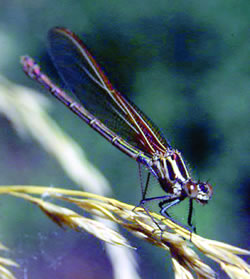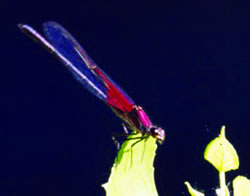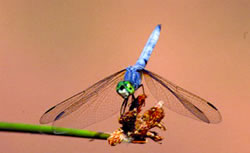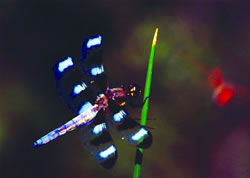Summer
is the time for damsels and dragons, but I don’t
mean those in distress or the fire-breathing kind.
No, I mean damselflies and dragonflies – winged
insects far older than their medieval namesakes.
Both groups of insects are in the order Odonata (meaning “toothed
ones”), but they are somewhat different in appearance
in both the larval and adult stages. Adult damselflies
have similar shaped wings that are folded over their
bodies when at rest (except for the spread-winged damselfly)
and dragonflies hold their wings out at rest. A dragonfly’s
hind wing is broader at the base than the front wing,
and they are much stronger fliers than damselflies. Also,
the large eyes of a dragonfly meet at a seam in the back
of the head. These wraparound eyes contain over 30,000
lenses and provide a 360-degree field of view.
Damselflies have eyes that are spread further apart,
much like those on a hammerhead shark.
In their aquatic larval stage, damselflies are more streamlined
and sport 3 projections on their tail end. These leaflike
structures are gills. Dragonfly larvae are more compact
and heavier than their relatives are. They keep their
gills inside their abdomen, located just inside their
butts. When pursued by prey the dragonfly larvae squirts
water out their backside, moving them along by jet propulsion.
Damselflies crawl along the bottom or squiggle through
the water.
To mosquitoes it doesn’t matter the life stage
of either insect, for damselflies and dragonflies, in
particular, prey upon both the larval and adult “skeeters.” An
adult dragonfly consumes about 300 mosquitoes a day.
Damselflies feed more on aphids, young grasshoppers,
and other insects, as well as mosquitoes.
Though highly beneficial, dragonflies were once considered “snake
doctors” and “devil’s darning needles” because
of their ancestral appearance. Folk people thought the
long hind end of a dragonfly contained a stinger, capable
of injecting poison. But this appendage is like a tow-truck
grappling hook on the males and an egg-depositor on the
females.
When breeding, a male damsel or dragonfly will use their
grappling hook like tip to lock onto a female’s
head as she deposits her eggs in the water. The pair
resembles a glider and tow plane. Both lay their eggs
in water and their larval stages are fierce aquatic predators.
Both have a lower lip or labium that folds under the
chin when not in use. When prey swim into range, the
lip quickly projects outwards and snags the creature.
It is pretty interesting to watch damselfly larvae slowly
turning about in the water while they focus on their
prey. They are like aquatic cats, waiting to pounce.
When the larvae are ready for adulthood, they emerge
from the water and crawl up onto the ground or nearby
vegetation. Their skin splits down from the head and
out comes the adult. Until their wings and body segments
dry and harden, these adults are vulnerable to predators
such as birds, frogs or snakes. Once airborne, dragonflies
may fly up to 35 m.p.h. and they can fly backwards, stop
abruptly in midair and hover like a helicopter.
These ancient aerialists have a long history on the Earth – some
325 million years. Fossil records indicate that these
insects were once the size of crows. Imagine the size
of prey they must have eaten! It gives new meaning to
the concept of an insect bite.
So during July, when you are seeking the cooler retreats
along canyon streams or higher elevation pools take a
few moments to see if there are any damsels or dragons
lurking beneath the surface or lording over the air.
I think you’ll enjoy their antics and appreciate
their hearty appetites. |




|